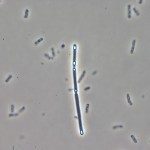Link to Pubmed [PMID] – 9881095
Bioorg. Med. Chem. 1998 Nov;6(11):2041-9
While the molecular basis of HIV-1 AZT resistance has been widely studied, a biochemical explanation of this process is not well known. No significant changes in the binding affinity of reverse transcriptase (RT) mutants for AZT-triphosphate has been found. Here we analyzed the interaction of wild type and AZT-resistant mutant forms of HIV-1 RT with different primers. Site-directed mutagenesis was used to introduce point mutations on the retroviral enzyme. Primers were either synthetic oligonucleotides or tRNA(Lys3) derivatives containing d(pT)n or r(pU)n at the 3′ end. In all cases, determination of kinetic parameters was done in the presence or absence of compounds known to modify protein conformation, such as dimethyl sulfoxide (DMSO), urea, and Triton X-100. Although we found similar K(m) values for all RTs, there was generally an increase in the affinity when enzymes were tested in the presence of DMSO, urea, and Triton X-100. Then, we analyzed the nucleation and elongation steps of the polymerization process. The efficiency of formation of the first base pair was determined by measuring K(m1), the affinity between RT and the 3′ terminal nucleotide of the primer. An important difference was found: in the presence of DMSO, urea, and Triton X-100, the K(m1) values for mutated enzymes were higher than those of wild type RTs. Thus, the presence of compounds able to change protein conformation led to a marked destabilization of the interaction of mutated RTs with the 3′ terminal nucleotide of the primer. From these results, it can be hypothesized that resistance to AZT is not due to the direct influence of mutations on RT, but rather to conformational changes of the mutated RT in complex with the template-primer altering the ability of the enzyme to select or reject an incoming dNTP.

